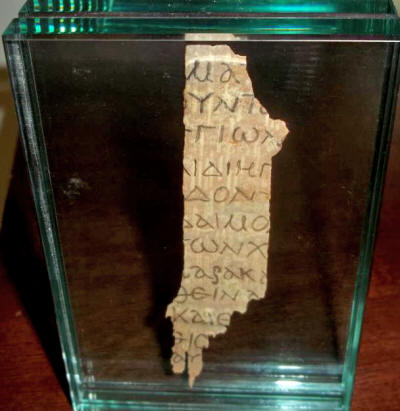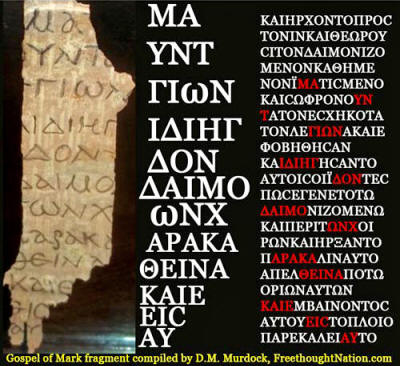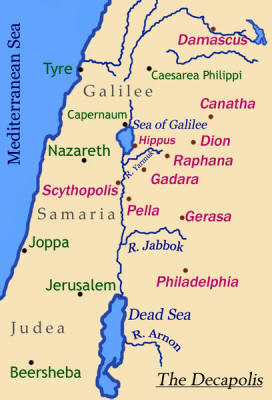|

by Acharya S
19 February 2012
from
FreeThoughtNation Website
The New
Testament blogosphere is all abuzz with news of a purported papyrus
discovery that comprises fragments of some
19 or more different
Bible manuscripts, including a small piece of the Gospel of Mark.
A
Christian professor relates that "one of the world's leading
paleographers" has dated the Mark fragment to the first century,
making it the earliest extant biblical text so far known. According
to the professor, Dr. Daniel Wallace, this discovery will be
published by the academic press E.J. Brill sometime within the
coming year.
First of all, we must remain cautious about such declarations
because we have ample precedent of overly enthusiastic
interpretations of supposed biblically relevant artifacts and texts.
One such artifact that immediately comes to mind is the Dead Sea
scroll fragment 7Q5 touted by scholars Josep O'Callaghan Martínez
and Carsten Thiede as another fragment from the Gospel of Mark, also
enthusiastically dated to the first century.
That effort fell flat,
as it was not accepted by the mainstream scholarly community.
Moreover, we have seen numerous examples of other hyped artifacts
such as the so-called Jesus Family Tomb, James Ossuary and Tomb of
Peter, etc., et al., all left in the dustbin of "pious fraud" or
just plain fraud.
Paleography is not an exact science
Secondly, it should be kept in mind that paleography is an imprecise
science, especially when it comes to this era, so if this thesis
relies only on a fragment dated by one paleographer, we shouldn't
become too excited.
The emphasis by some on the paleographer in this
case not being a Christian - and therefore less likely to be biased
- is immaterial if he nevertheless follows the mainstream timeline
of Christian history and is attempting to push the date back as
early as possible to make it fit that timeline.
The reality is that,
similar to carbon-14 dating, paleography has a + or - factor of
about 25 to 50 (or more) years, meaning that even if the
paleographer placed the papyrus at the end of the first century, it
could in fact date to the middle of the second or even later.
As New
Testament scholar Dr. Larry Hurtado remarks:
..because paleographical dating can rarely be more precise than +/-
25 to 50 years, the proposed dating of many manuscripts will lie
across two centuries...
About this particular discovery, Hurtado has already weigh in,
likewise advising caution:
The identification and palaeographical dating of manuscripts
requires huge expertise specific to the period and texts in
question. Let’s wait and see whose judgment lies behind the claims.
Palaeographical dating can ever only be approximate, perhaps as
narrow as 50 yrs plus or minus.
Expert palaeographers often disagree
over a given item by as much as a century or more. It’s never wise
to rest much upon one judgment, and confidence will be enhanced
only when various experts have been given full access to the items.
It is particularly difficult to make a palaeographical dating of a
fragment, the smaller it is the more difficult. For such dating
requires as many characters of the alphabet as possible and as many
instances of them in the copy as possible to form a good judgment
about the “hand”.
Although it ratchets up potential sales of a publication to make
large claims and posit sensational inferences about items, it
doesn't help the sober scholarly work involved. It also doesn't
actually accrue any credit or greater credibility for the items or
those involved in handling them.
I would be surprised if Brill publishes such an endeavor, if the
conclusions are based only on one paleographic assessment.
Other
factors must be included, such as possible anachronisms, as well as
the provenance, first appearance in the literary record, comparative
literature, etc.
The Gospel of Mark papyrus fragment
On
our forum, an image was posted
(below) that is claimed to be the fragment
in question, which contains parts of several words from Mark
5:15-18.

Let's look at Mark 5:15-18, first in English, followed by
the original Greek (textus receptus):
And they came to Jesus, and saw the demoniac sitting there, clothed
and in his right mind, the man who had had the legion; and they were
afraid. And those who had seen it told what had happened to the
demoniac and to the swine. And they began to beg Jesus to depart
from their neighborhood. And as he was getting into the boat, the
man who had been possessed with demons begged him that he might be
with him.

Ancient Greek was originally written "as the ox plows" or in
boustrophedon, which means back and forth from line to line, with no
spaces or punctuation between words. In the Codex Sinaiticus (c.
330-360), one of the earliest extant Bible manuscripts, the writing
is left to right, but it still has no punctuation and no spaces
between the words.
The lines are divided not at the end of words but
according to syllables.
I have cropped the purported image of the Mark fragment and added
its visible letters, along with a comparable passage from the Codex
Sinaiticus, in which I have highlighted in red the fragment letters.

Gospel of Mark fragment, highlighted letters and Codex Sinaiticus
(I should note that the Greek letter
 in the fragment "αρακα" in the fragment "αρακα"
is the wackiest looking rho I've ever seen.)
Uncial script popular from 3rd to 8th
centuries AD/CE
The Mark inscription appears to be in
uncial script, which was used
commonly from the 3rd to 8th centuries AD/CE. It seems impossible to
pinpoint this fragment to the first century based solely on the
paleography, especially since the inscription is in uncial.
Here are the Greek uncials:

(In this regard, it should be noted that the uncial lettering here
is not all caps. The omega, for example, is lowercase, as is the
alpha, after a fashion, and the lambda. In addition, the sigma is
not the typical "s" shape but is a "c" in uncial.)
The demoniac
and the swine
Let us take a look at the New Testament motif recorded in this
fragment, for more clues as to its possible provenance and era:
And they came to Jesus, and saw the demoniac sitting there, clothed
and in his right mind, the man who had had the legion; and they were
afraid. And those who had seen it told what had happened to the
demoniac and to the swine. And they began to beg Jesus to depart
from their neighborhood. And as he was getting into the boat, the
man who had been possessed with demons begged him that he might be
with him.
This chapter (5) of Mark concerns a man with an "unclean spirit" who
"lived among the tombs" of a certain country and who possessed
supernatural strength and could not be bound.
The possessed man
wanders about forlornly until he sees Jesus, whom he worships and
who rebukes the unclean spirit, which identifies itself as "Legion,
for we are many."
Nearby is a "great herd of swine," and the legion beg Jesus to send
them into the swine, which he does, driving the pigs into the sea,
thus killing the demons as well.
After the townsfolk freak out,
Jesus goes to leave in a boat, and the demoniac begs to go along.

Ancient Judea and Samaria,
with the Sea of Galilee, Gerasa and the
Dead Sea
There are many reasons why this story cannot possibly be
historical, not the least of which is the supernatural possession of
a man by demons who identify themselves as "legion" and who are
driven into swine and then somehow killed, even though they are
already from the land of the dead.
In addition to that incredible
aspect of the story, the locale of the tale is garbled, with the
country's name, for example, recorded variously in different gospels
and editions of the New Testament. Moreover, the only "seas" that
could have received these swine are the Dead Sea and Sea of Galilee,
dozens of miles away from where this area was purported to be, i.e., Gerasa.
Rather than representing implausible "history," this theme is highly
suggestive of the myth of the Egyptian afterlife god Osiris in the
Hall of Judgment, driving off the devilish swine when the deceased
petitioner goes before him.
As related in
Christ in Egypt (241), to
quote W. Cooper:
Having quitted the boat of the river of Hades, the deceased is met
by the god Anubis, who conducts him in safety through the devious
windings of an intricate labyrinth, and leaves him at the threshold
of the judgment-hall of Osiris, the hall of the Two Truths.

Osiris in the Hall of Judgment,
weighing the deceased and sending
off in a boat a pig,
who represents Set or 'Satan' (Louvre,
sarcophagus)
In the judgment hall, if the deceased is not
sufficiently pure, he is changed into a pig and "reconveyed to earth
by Anubis in a boat."
An impure or unclean spirit or deceased person
wandering about the "tombs" of the afterlife is changed into a pig
and sent into the abyss, so to speak, which is what the return to
Earth would represent to the Egyptian faithful, a punishment whereby
the deceased must continue on the path of purification.
In the
gospel story, the "impure spirits" are basically changed into pigs
by the god. The demoniac begging to go with the savior in the boat
sounds like a change of heart by the purified deceased wishing to
return to life on Earth.
It appears that, like so much else of the Christian effort, this
demons-swine motif was borrowed from another religion/mythology, in
this case the Egyptian.
The adoption of much Egyptian religion and
mythology into Christianity began in earnest during the second
century and continued for several centuries afterwards.
Conclusion
With all these factors, I suspect the provenance of this papyrus
fragment is Egypt, possibly from or near St. Catherine's Monastery.
Again, I see no reason from a paleographical analysis of this small
fragment alone to push its date into the first century, especially
since it certainly could be from the second, third or later
centuries and since there is no evidence that the canonical gospel
of Mark as we have it existed at that time.
Indeed, none of the
canonical gospels clearly emerges into the historical record until
the end of the second century.
|





